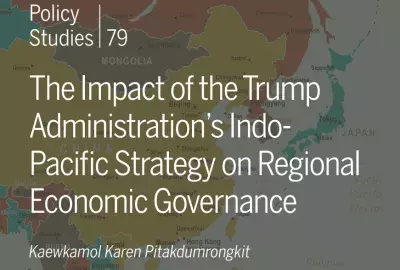Error message

This study examines the drafting and implementing of special autonomy laws for Aceh and Papua as part of the Indonesian government's broader response to secessionist challenges in both provinces. The background to the political decision to grant special autonomy to Aceh and Papua is examined while also presenting a detailed examination of each law. The objective of this analysis is to provide a case study for policymakers and academics seeking to understand the dynamics of separatism. The analysis seeks appropriate policy responses to the challenge of secessionist movements and outlines the conditions under which granting autonomy may or may not be conducive to addressing separatist conflict. As this study illustrates, special autonomy laws were drafted in Indonesia as a response to rapidly growing independence movements in Aceh and Papua that followed the collapse of the authoritarian regime of President Suharto in 1998. Responding to mounting violence, the government offered special autonomy laws in a bid to divert secessionist demands. This offer of "asymmetric" autonomy in fact contained significant and special concessions for Aceh and Papua. Special autonomy was the product of an opportune moment of Indonesia's democratic transition in which the government faced multiple crises and central authority was at a weak point. With pro-independence movements intensifying their pressure on Jakarta, the government was impelled to make major concessions as a way of staving off crisis and keeping the country together. It was not long, however, before the government was able to close down the political space for independence leaders and their supporters, and address other crises challenging the state. As the government reconstituted central authority, the imperatives that had driven the decision to grant special autonomy eased. And as the government's commitment to special autonomy faltered, it soon turned to more coercive measures to respond to separatist demands. By 2003, the government was pursuing an alternative strategy of imposing martial law in Aceh and subdividing Papua, a strategy that eclipsed special autonomy and signaled a return to a more coercive, less accommodating, posture. In presenting the case study of Aceh and Papua, this essay confirms a central theme of the comparative literature on autonomy: the fragility of such arrangements and their vulnerability to reversal. Special autonomy arrangements are exceedingly difficult to entrench as national elites almost always resist demands to devolve political authority and are suspicious of any initiative that may set a precedent for other regions. This is particularly the case in large multiethnic countries such as Indonesia where the state faces an array of possible challenges to its authority. A driving force in the Indonesian government's backsliding, for instance, was the official concern that special autonomy was fuelling separatism rather than resolving it. In conceding special rights to Papua and Aceh, officials feared a cascade of similar demands from other regions. All of this suggests that special autonomy, in and of itself, does not represent a solution to separatist conflict. Rather, the concessions that are offered under special autonomy must be part of a broad process of bargaining and negotiation. In the absence of official negotiation with popular elements, autonomy arrangements typically fail to generate widespread support. In this context, central governments, which have many incentives to roll back autonomy, incur few costs in doing so. As this study illustrates, the provincial elites and national parliamentarians that formulated and enacted special autonomy in Indonesia did so largely in isolation from popular elements in both provinces. Special autonomy represented a unilateral concession on the part of Jakarta that lacked any links to the main political forces advocating independence in either province. What has been missing to date is a systematic bargaining process between Jakarta and the regions—one that links concessions granted under the laws with a wide-ranging dialogue involving key elements of Papuan and Acehnese society. This study concludes by examining these comparative themes while also discussing the future prospects for special autonomy in Indonesia. Neither ad hoc unilateral concession making nor the subsequent shift to coercive measures has resolved separatist conflict in Aceh or Papua. In fact, the adoption of more coercive means has not only failed to address the underlying causes of injustice driving both conflicts but has actually exacerbated the alienation of local populations from the state. As a result, the government may again turn to special autonomy as a means to address separatism. The laws remain in place and revenues from autonomy continue to be allocated. But even if Jakarta does strike a more committed posture toward special autonomy, the government will need to move beyond the ad hoc policy responses of the past. At a bare minimum, a link must be established between, on the one hand, the unilateral concessions offered under the laws and, on the other, a systematic bargaining process between Jakarta and the regions to build support for resolving the conflicts. Without linking concessions to dialogue, Aceh and Papua are likely to represent a continuing source of conflict and secessionism for the Indonesian state. | Additional titles in the Policy Studies series |

This study examines the drafting and implementing of special autonomy laws for Aceh and Papua as part of the Indonesian government's broader response to secessionist challenges in both provinces. The background to the political decision to grant special autonomy to Aceh and Papua is examined while also presenting a detailed examination of each law. The objective of this analysis is to provide a case study for policymakers and academics seeking to understand the dynamics of separatism. The analysis seeks appropriate policy responses to the challenge of secessionist movements and outlines the conditions under which granting autonomy may or may not be conducive to addressing separatist conflict. As this study illustrates, special autonomy laws were drafted in Indonesia as a response to rapidly growing independence movements in Aceh and Papua that followed the collapse of the authoritarian regime of President Suharto in 1998. Responding to mounting violence, the government offered special autonomy laws in a bid to divert secessionist demands. This offer of "asymmetric" autonomy in fact contained significant and special concessions for Aceh and Papua. Special autonomy was the product of an opportune moment of Indonesia's democratic transition in which the government faced multiple crises and central authority was at a weak point. With pro-independence movements intensifying their pressure on Jakarta, the government was impelled to make major concessions as a way of staving off crisis and keeping the country together. It was not long, however, before the government was able to close down the political space for independence leaders and their supporters, and address other crises challenging the state. As the government reconstituted central authority, the imperatives that had driven the decision to grant special autonomy eased. And as the government's commitment to special autonomy faltered, it soon turned to more coercive measures to respond to separatist demands. By 2003, the government was pursuing an alternative strategy of imposing martial law in Aceh and subdividing Papua, a strategy that eclipsed special autonomy and signaled a return to a more coercive, less accommodating, posture. In presenting the case study of Aceh and Papua, this essay confirms a central theme of the comparative literature on autonomy: the fragility of such arrangements and their vulnerability to reversal. Special autonomy arrangements are exceedingly difficult to entrench as national elites almost always resist demands to devolve political authority and are suspicious of any initiative that may set a precedent for other regions. This is particularly the case in large multiethnic countries such as Indonesia where the state faces an array of possible challenges to its authority. A driving force in the Indonesian government's backsliding, for instance, was the official concern that special autonomy was fuelling separatism rather than resolving it. In conceding special rights to Papua and Aceh, officials feared a cascade of similar demands from other regions. All of this suggests that special autonomy, in and of itself, does not represent a solution to separatist conflict. Rather, the concessions that are offered under special autonomy must be part of a broad process of bargaining and negotiation. In the absence of official negotiation with popular elements, autonomy arrangements typically fail to generate widespread support. In this context, central governments, which have many incentives to roll back autonomy, incur few costs in doing so. As this study illustrates, the provincial elites and national parliamentarians that formulated and enacted special autonomy in Indonesia did so largely in isolation from popular elements in both provinces. Special autonomy represented a unilateral concession on the part of Jakarta that lacked any links to the main political forces advocating independence in either province. What has been missing to date is a systematic bargaining process between Jakarta and the regions—one that links concessions granted under the laws with a wide-ranging dialogue involving key elements of Papuan and Acehnese society. This study concludes by examining these comparative themes while also discussing the future prospects for special autonomy in Indonesia. Neither ad hoc unilateral concession making nor the subsequent shift to coercive measures has resolved separatist conflict in Aceh or Papua. In fact, the adoption of more coercive means has not only failed to address the underlying causes of injustice driving both conflicts but has actually exacerbated the alienation of local populations from the state. As a result, the government may again turn to special autonomy as a means to address separatism. The laws remain in place and revenues from autonomy continue to be allocated. But even if Jakarta does strike a more committed posture toward special autonomy, the government will need to move beyond the ad hoc policy responses of the past. At a bare minimum, a link must be established between, on the one hand, the unilateral concessions offered under the laws and, on the other, a systematic bargaining process between Jakarta and the regions to build support for resolving the conflicts. Without linking concessions to dialogue, Aceh and Papua are likely to represent a continuing source of conflict and secessionism for the Indonesian state. | Additional titles in the Policy Studies series |








